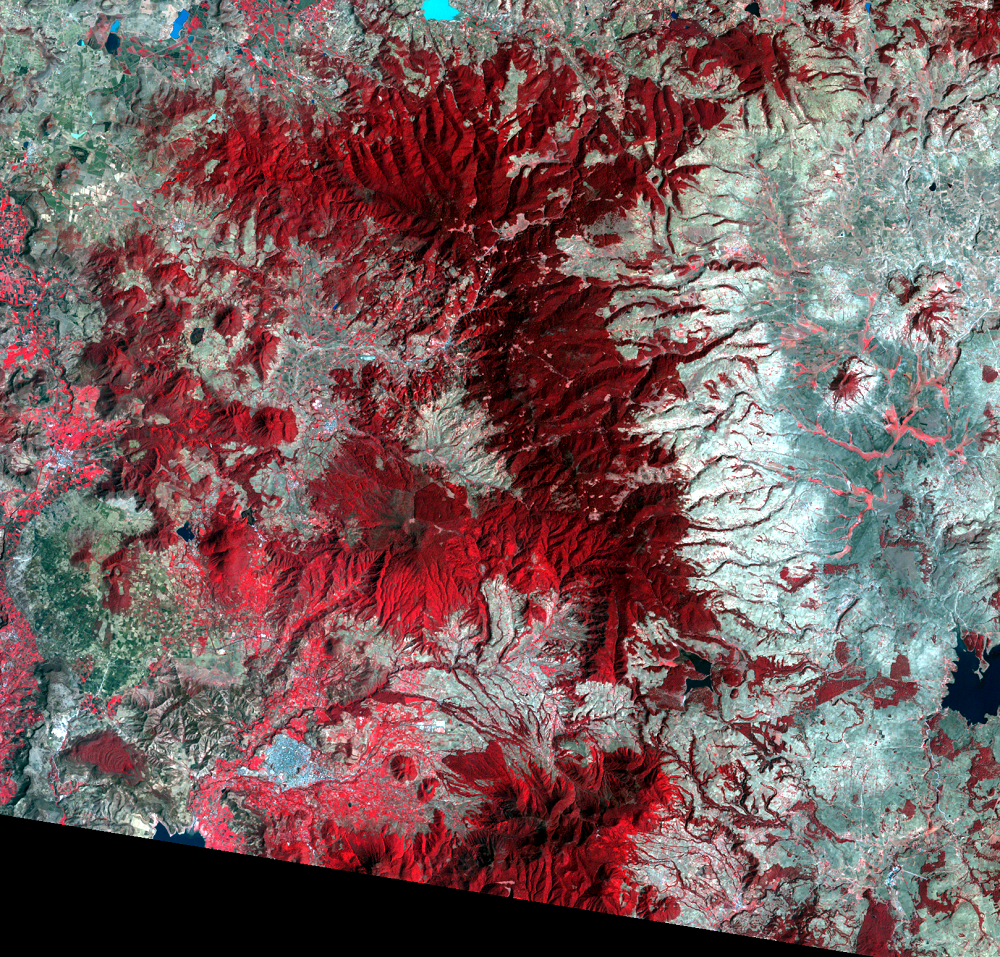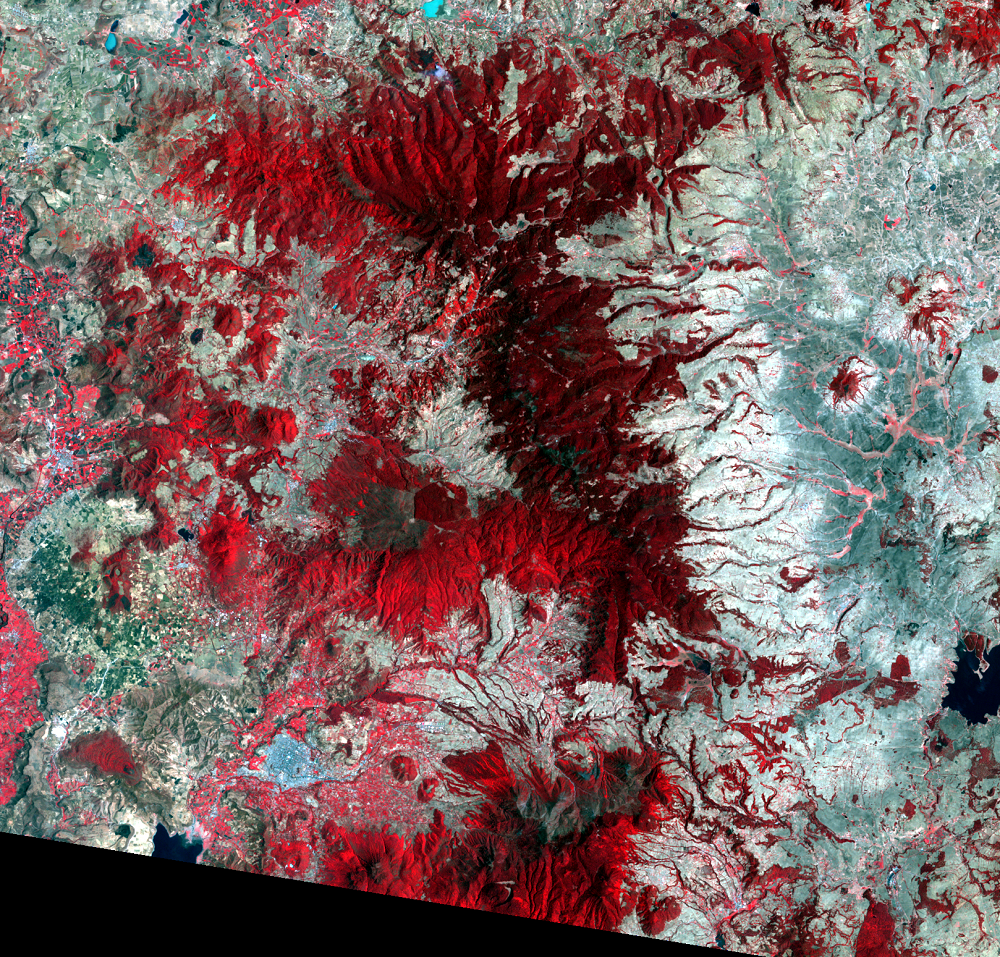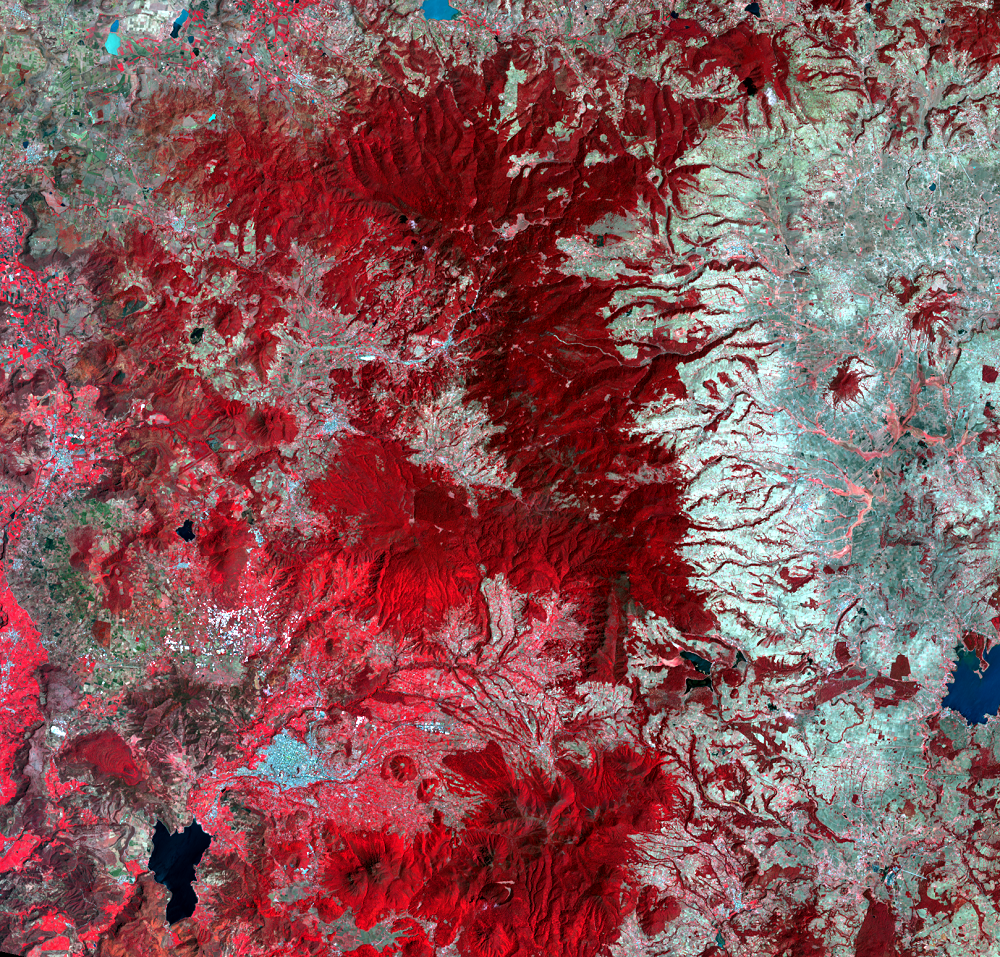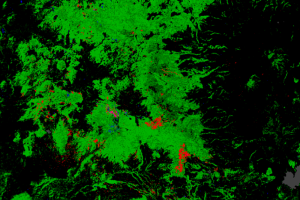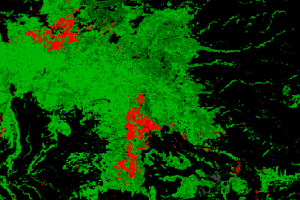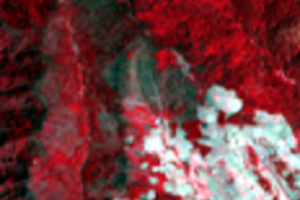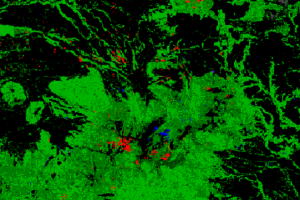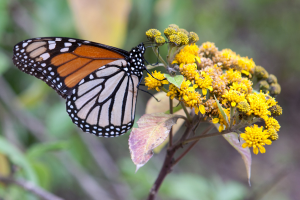
Monarch Butterflies, Mexico
Earth Resources Observation and Science (EROS) Center - Earthshots
The patches of red in these false-color Landsat images are the forests where monarch butterflies spend the winter. Starting in late summer and fall, monarchs in the United States and Canada migrate south to Mexico. Some travel up to 3,000 miles. The delicate insects are capable of flying 50–100 miles a day.
Cold weather drives the monarchs to head south to hibernate for the winter. They head for the only habitat suitable for their hibernation, oyamel fir (Abies religiosa) forests. These forests grow in only small areas of mountain tops in central Mexico, about 3,000 m above sea level. The monarchs usually cover whole trees as they keep each other warm. The short needles of the oyamel fir allow the butterflies to cluster together better than they could on flat-needled cedars or long-needled pines.
The oyamel forests provide a microclimate for the butterflies. Temperatures stay above freezing. If the temperatures were lower, the monarchs would have to use their fat reserves. The humidity provided by the forest also keeps them from drying out.
The monarchs stay in Mexico from about November to March. In the spring, they fly back north. On the way, they lay eggs on milkweed. These eggs hatch into caterpillars, who devour the milkweed leaves, then metamorphose into monarchs. These monarchs live about 5 weeks or so.
What’s especially amazing about the monarch migration is that not all monarchs take part in the journey. And unlike birds and whales, the monarchs that do complete the migration only make one round trip.
The great-grandchildren of the overwintering monarchs migrate south the next fall, somehow landing at the same trees as their ancestors. Without the use of maps or satellite imagery!
Imagery
Downloads
Brower, L.P., Williams, E.H., Fink, L.S., Zubieta-Hernández, R.R., and Ramírez, M. I., 2008, Monarch Butterfly Clusters Provide Microclimatic Advantages during the Overwintering Season in Mexico: Journal of the Lepidopterists’ Society, v. 62, no. 4, p. 177–188.
Brower, L.P., Taylor, O.R., Williams, E.H., Slayback, D.A., Zubieta, R.R., and Ramírez, M.I., 2012, Decline of Monarch Butterflies Overwintering in Mexico—Is the Migratory Phenomenon at Risk? Insect Conservation and Diversity, v. 5, no. 2, p. 95–100.
Diffendorfer, J.E., Loomis, J.B., Ries, L., Oberhauser, K., Lopez-Hoffman, L., Semmens, D., Semmens, B., Butterfield, B., Bagstad, K., Goldstein, J., Wiederholt, R., Mattsson, B., and Thogmartin, W.E., 2014, National Valuation of Monarch Butterflies Indicates an Untapped Potential for Incentive-Based Conservation: Conservation Letters, v. 7, no. 3, p. 253–262. (Also available online at http://onlinelibrary.wiley.com/doi/10.1111/conl.12065/full.)
Hansen, M.C., Potapov, P.V., Moore, R., Hancher, M., Turubanova, S.A., Tyukavina, A., Thau, D., Stehman, S.V., Goetz, S.J., Loveland, T.R., Kommareddy, A., Egorov, A., Chini, L., Justice, C.O., and Townshend, J.R.G., 2013, High-Resolution Global Maps of 21st-Century Forest Cover Change: Science, v. 342, no. 6160, p. 850–853. (Data available online at http://earthenginepartners.appspot.com/science-2013-global-forest.)
Monarch-butterfly.com, [n.d.], Monarch Butterfly Facts: monarch-butterfly.com Web page at http://www.monarch-butterfly.com/monarch-butterflies-facts.html. (Accessed June 12, 2015.)
Monarch Lab, 2015, Annual Life Cycle: Monarch Lab, University of Minnesota Web page at http://monarchlab.org/biology-and-research/biology-and-natural-history/breeding-life-cycle/annual-life-cycle. (Accessed June 12, 2015.)
Monarch Lab, 2015, Migration: Monarch Lab, University of Minnesota Web page at http://monarchlab.org/biology-and-research/biology-and-natural-history/migration/. (Accessed June 12, 2015.)
NASA, 2008, Deforestation in Monarch Butterfly Reserve: NASA Earth Observatory, available at http://earthobservatory.nasa.gov/IOTD/view.php?id=8506. (Accessed June 12, 2015.)
National Geographic, [n.d.], Monarch Butterfly: National Geographic Web page at http://animals.nationalgeographic.com/animals/bugs/monarch-butterfly/. (Accessed June 12, 2015.)
Semmens, B.X., Semmens, D.J., Thogmartin, W.E., Wiederholt, R., López-Hoffman, L., Diffendorfer, J.E., Pleasants, J.M., Oberhauser, K.S., and Taylor, O.R., 2016, Quasi-extinction risk and population targets for the Eastern, migratory population of monarch butterflies (Danaus plexippus): Nature, Scientific Reports, v. 6, no. 23265, available online at http://www.nature.com/articles/srep23265.
Slayback, D.A., Brower, L.P., Ramírez, M.I., and Fink, L.S., 2007, Establishing the Presence and Absence of Overwintering Colonies of the Monarch Butterfly in Mexico by the Use of Small Aircraft: American Entomologist, v. 53, no. 1, p. 28–40.
Taylor, C., 2014, Monarch Population Status: MonarchWatch.org Web page at http://monarchwatch.org/blog/2014/01/monarch-population-status-20/. (Accessed June 12, 2015.)
Taylor, C., 2015, Monarch Population Status: MonarchWatch.org Web page at http://monarchwatch.org/blog/2015/01/27/monarch-population-status-22/. (Accessed June 12, 2015.)
Taylor, C., 2016, Monarch Population Status: MonarchWatch.org Web page at http://monarchwatch.org/blog/2016/02/26/monarch-population-status-26/. (Accessed March 24, 2016.)
USDA Forest Service, [n.d.], Migration and Overwintering: USDA Forest Service Web page at

